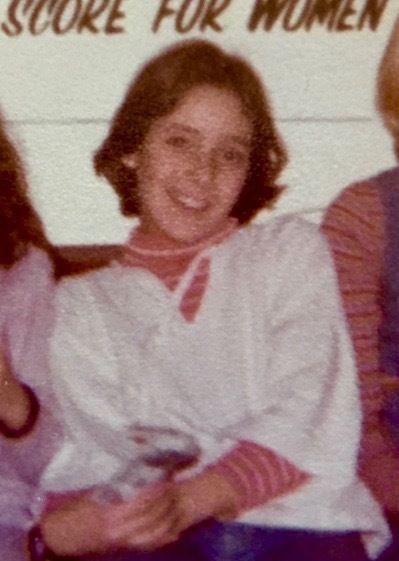It was airless and humid the night I heard. My bedroom walls obscured by Duran Duran posters, on the floor, I’d made a pile of clothing and books for college. The phone rang from under it.
My memory conjures what happened in staccato-like frames, like a GIF that moves only seconds before disappearing. A friend’s voice says, “Someone found her in Central Park. They think she was murdered.” I try to speak, but can’t. Next, I’m on the floor. My mother stands over me with the phone in her hand, and I sob.
Thirty years ago, the murder of Jennifer Levin sparked national debates about under-age drinking, sexual promiscuity, and the rise of tabloid news. For me, the incident was a brutal personal loss. Jen and I had been friends since the fourth grade, and the enormity of her death was overwhelming. In my room, the pile I’d made for college remained frozen. The morning after, the newspaper’s headline read Her Boyfriend Did It, the first of hundreds during a media frenzy that would last years.
Jen’s murder was underscored by sensationalism, misinformation disseminated as if from a Victorian penny dreadful: the scandalous tid-bits, the hysterical it-could-have-been-me’s. Grieving within a private realm was an impossible task because Jen stared out from every magazine and television screen. At first, she was “Jenny” the all-American model. Next, she was the equally fictitious siren, picking up men in bars.
But there was the real Jennifer Levin. As a child she, like me, didn’t fit in. She was a troublemaker who, on the whole, made little trouble. She was mischievous but kind, with a wicked sense of humor. Pretty, she was more tomboy than coquette. She sometimes acted the angry child of divorce, yet had good-natured laughter in her eyes, and was never mean, an anomaly in a sea of schoolyard bullies. During recess at our junior high on Long Island, I would sit, my face behind a book, trying to look invisible. One day, Jen walked over and said, “Don’t worry, I won’t let them bother you.”
We lost touch after she moved to Manhattan to live with her father, a decision that surprised me since Jen was close to her mother and sister. But neither of us were happy where we lived, and I was envious she found a way out.
Years later, I tagged along with a friend to a party in SoHo, at that time a bohemian art hub. The iron elevator of the former factory opened: and there was Jen, standing in her dad’s loft. She looked more polished than she used to, but she screamed and hugged me, laughing as if we were still twelve years old.
One night, we met at an upper-east side bar, carrying fake I.D.s. used to get into dance clubs. I remember Dorian’s Red Hand as dull, with well-groomed patrons standing around, impassive. The excursion seemed odd because Jen didn’t even drink. Months later, Dorian’s became emblematic of a culture of children running amok.
My own experience was that my friends’ parents viewed them as young adults capable of taking care of themselves. This is not how we parent our own children today, but 1980s New York was orchestrated by adults for adults.
From the moment I learned of Jen’s murder, real adulthood commenced through grief and shock. My innocence was worn away by reliving “The Preppy Murder” through explicit, relentless scandal masquerading as news, broadcast into America’s living rooms. These days, there’s nothing shocking in this. But we did not have smart phones, then; ordinary people didn’t bare their secrets on TV; there was no Google to fact-check.
Robert Chambers was described in articles as a saintly alter boy instead of a drug-dealer expelled from school, and photographed like a movie star for the front covers of magazines. A television show aired a video taken by a friend I never spoke to again: Robert, high and acting out murdering a Barbie doll. Still, no one came to Jen’s defense.
In college, I sank into an unhealthy relationship with my boyfriend and dropped out for a term. My health—fragile from undiagnosed endometriosis—grew worse. I developed shingles with a constricted diaphragm that made me feel suffocated.
Around this time, I had an uncanny dream. I was playing with friends like a child and Jen suddenly appeared. Surrounded by glowing light, she approached. I cried and she hugged me and said, “Please don’t worry, I’m okay.”
When Chambers’ lawyers smear campaign against Jen escalated, I called the Manhattan D.A.’s office to speak to Linda Fairstein, the assistant D.A. for the prosecution. My heart was racing. “I have information about Robert Chambers.”
A few hours later, Mike Sheehan came to my apartment. A big, tough but warm Irish cop, he was like a character out of a detective series. He would, years later, reinvent himself as a reporter and television crime show developer, just as Fairstein would become a legal consultant for CNN and write dozens of novels.
Sheehan, looking at his notepad, said, “After we made a few calls, it was clear Jennifer’s friends wouldn’t speak to us.”
“I’ll speak to you,” I said, “if you tell me what really happened to her.”
Sheehan raised his eyes. “You don’t want to know.”
“Yes I do.”
That day, I learned what hadn’t been reported in the news: that Jen’s body was brutalized in a way that did not belie a consenting sex act; that, in fact, the nature of multiple wounds and evidence found for 25 feet around the crime scene proved her attempts at escaping a ferocious attack.
I told Sheehan that Chambers burglarized apartments and sold drugs with someone I named; that he had once broken the arm of his girlfriend, whom I named. Drug charges would contribute to additional years on the sentence Chambers eventually served, but nothing I said did anything to change the public’s view of Jen, or of Chambers, at the time.
Jen’s reputation was dragged through the mud, as her killer had dragged her across the knoll in Central Park. Missing from the news was that specific detail because it was deemed too upsetting. The jury deliberated over an inane rough sex defense and the prosecution accepted a plea bargain for manslaughter with a meager five-to-fifteen year sentence, less than the sentence he currently serves for dealing drugs after his 2003 release.
During the trial, Curtis and Lisa Sliwa and their Guardian Angels held signs proclaiming Justice For Jennifer (both are now media personalities). Afterwards, a lobbying group for victims’ rights renamed Justice For All was co-founded by Jen’s mother, Ellen Levin. It’s because of Jen’s death that the drinking age was raised to 21. It’s because of Jen’s death that attorneys can no longer put a victim on trial if she isn’t alive to defend herself.
There has been one public moment in all these years that accurately reflected my private view of Jen, when I caught Ellen in a rare television interview. She told of Jen coming to her in a dream surrounded by a haze of warm light, and of how Jen embraced her and said, “I’m okay.”
It took me a year to be able to visit Jen’s grave. It was a beautiful day. The plot was easily visible, welcoming and open as Jen had been. Her headstone read: A Free and Loving Spirit. There were little stones placed along the top and some on the ground where older flowers lay wilted: the remnants of those who loved her.
I cleared the old flowers and a clump of weeds, and placed fresh, pale-pink roses down. I stood alongside the grave. Thinking of Jen’s vibrancy and warmth, I changed my mind and laid down the length of the plot. I closed my eyes and pressed my cheek to the grass as if hugging her. I said, “Jen, it’s me. Thank you for coming to visit me. I’m sorry I couldn’t visit you sooner. I’m so sorry.”

